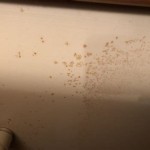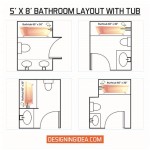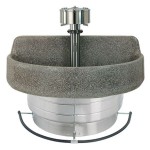How to Remove a Bathroom Tub Drain Plug
Removing a bathroom tub drain plug might seem like a simple task, but different types of plugs and the potential for accumulated debris can make it more challenging than anticipated. This article provides a detailed guide on how to remove various types of bathtub drain plugs, common problems encountered, and essential tools required for the task.
Understanding the type of drain plug installed in the bathtub is the first crucial step. There are several common types, each with its own removal method. Identifying the specific type will streamline the removal process and minimize the risk of damaging the drain assembly or the bathtub itself.
Before starting any drain plug removal attempt, safety precautions are necessary. Turning off the water supply to the faucet can prevent accidental flooding should something go wrong during the process. Gathering the necessary tools and having them readily available will also contribute to a smoother and more efficient removal.
Identifying Common Types of Bathtub Drain Plugs
Several types of bathtub drain plugs are commonly encountered, each operating on a different mechanism. Recognizing the type of plug is essential for choosing the appropriate removal method. The most common types include:
Pop-Up Drain Plugs: These are operated by a lever located either on the overflow plate (the plate with the hole beneath the faucet) or directly on the drain itself. The lever activates a mechanism that raises or lowers the plug.
Lift-and-Turn Drain Plugs: These plugs feature a knob or cap that is lifted, turned, and then lowered to engage or disengage the stopper. Often, they require a slight twisting motion while lifting.
Toe-Touch Drain Plugs: These plugs are operated by pressing down on the drain plug with a toe or foot. Pressing once seals the drain, and pressing again releases it.
Push-and-Pull Drain Plugs: Similar to the toe-touch type, these plugs require pressing down, but to release them, they need to be pulled up manually.
Stopper Drain Plugs: These are simple rubber or metal stoppers that are manually inserted into the drain opening to seal it. Removal is usually straightforward – simply pulling the stopper out.
Essential Tools for Drain Plug Removal
Having the right tools is essential for effectively removing a bathtub drain plug. While the specific tools may vary depending on the type of plug, the following are generally useful:
Screwdrivers (Flathead and Phillips): These are often needed for removing screws on drain levers, overflow plates, or for adjusting drain mechanisms.
Pliers (Regular and Needle-Nose): Pliers are useful for gripping and manipulating small parts, removing debris, or loosening stuck components.
Drain Removal Tool (Drain Key or Tub Drain Extractor): This specialized tool is designed to grip and turn the drain flange (the visible part of the drain in the tub) for removal.
Adjustable Wrench: An adjustable wrench can be useful for loosening or tightening various drain assembly components.
Penetrating Oil (e.g., WD-40): This can help loosen corroded or stuck parts of the drain assembly, making removal easier. Apply sparingly and allow it to sit for a few minutes before attempting to unscrew components.
Gloves: Wearing gloves protects hands from grime, sharp edges, and potential exposure to bacteria in the drain.
Shop Towels or Rags: These are useful for cleaning up spills and wiping down tools and surfaces.
Flashlight: A flashlight can help illuminate the drain area for better visibility, especially when working in dimly lit bathrooms.
Step-by-Step Removal Procedures for Different Drain Plug Types
The following sections detail specific instructions for removing each type of drain plug. Remember to consult the owner's manual for the bathtub or drain assembly if available, as it may contain specific instructions for the model being worked on.
Removing a Pop-Up Drain Plug:
1.
Locate the Overflow Plate:
Find the overflow plate on the wall of the bathtub, usually located below the faucet.2.
Remove Overflow Plate Screws:
Use a screwdriver to remove the screws holding the overflow plate in place. Carefully pull the plate away from the wall; a linkage rod will be attached to the back.3.
Detach the Linkage Rod:
The linkage rod connects to a rocker arm within the drain assembly. Examine how the rod is attached to the rocker arm. It might be a simple clip or a more intricate mechanism. Detach the rod carefully.4.
Remove the Drain Plug:
Once the linkage rod is detached, the drain plug should lift out from the drain opening. If it's stuck, gently wiggle it or use a pair of pliers to grip and pull it out. Be careful not to scratch the bathtub surface.5.
Clean the Drain Plug and Assembly:
After removing the plug, clean it and the surrounding drain assembly of any hair, soap scum, or debris. Reassemble the drain in reverse order.Removing a Lift-and-Turn Drain Plug:
1.
Loosen the Knob or Cap:
Most lift-and-turn plugs have a small set screw located on the side of the knob or cap. Use a small Allen wrench or screwdriver to loosen this set screw.2.
Unscrew the Knob or Cap:
Once the set screw is loosened, the knob or cap should unscrew counterclockwise from the drain stem. If it's stuck, apply a small amount of penetrating oil and wait a few minutes before trying again.3.
Remove the Drain Stem:
After the knob or cap is removed, the drain stem can be pulled out of the drain opening. It may be necessary to wiggle it gently to loosen any debris or corrosion.4.
Clean the Drain Plug and Assembly:
Clean the drain stem and surrounding area of any accumulated debris. Reassemble the drain in reverse order, tightening the set screw securely.Removing a Toe-Touch or Push-and-Pull Drain Plug:
1.
Inspect the Plug:
Examine the top of the drain plug. Some toe-touch/push-and-pull plugs have a small slot or recess where a screwdriver can be inserted.2.
Unscrew the Top (If Applicable):
If there is a slot, carefully insert a flathead screwdriver and attempt to unscrew the top of the plug counterclockwise. This may require some force if the plug is corroded or stuck.3.
Remove the Plug Body:
Once the top is unscrewed (or if there is no top to unscrew), the main body of the plug should be removable. Try to gently wiggle and pull it upward. If it's stuck, use pliers to grip the sides of the plug and pull it out. Be careful not to damage the drain housing.4.
Clean the Drain Plug and Assembly:
Thoroughly clean the plug and the drain opening. These types of plugs often accumulate a significant amount of hair and debris. Reassemble the drain in reverse order, if applicable.Removing a Stopper Drain Plug:
1.
Grip the Stopper:
If the stopper is loose, simply grip it firmly and pull it straight up and out of the drain opening.2.
Loosen a Stuck Stopper:
If the stopper is stuck, try using pliers to get a better grip. Gently twist the stopper back and forth while pulling upwards. Penetrating oil might help to loosen a corroded stopper.3.
Inspect for a Chain:
Some stopper drain plugs are attached to a chain that connects to a lever on the overflow plate. If there is a chain, detach it from the lever before attempting to remove the stopper.4.
Clean the Stopper and Drain Opening:
Once the stopper is removed, clean it thoroughly and remove any debris from the drain opening.Troubleshooting Common Problems During Drain Plug Removal
Even with the correct tools and procedures, certain issues can arise during the drain plug removal process. The following are some common problems and potential solutions:
Stripped Screws: If the screws on the overflow plate or drain assembly are stripped, making it difficult to remove them, try using a rubber band or steel wool between the screwdriver and the screw head to improve grip. Alternatively, a screw extractor tool can be used.
Corroded or Stuck Parts: Corrosion or mineral buildup can make it difficult to loosen drain assembly components. Applying penetrating oil and allowing it to soak for several minutes can help. Gentle tapping with a hammer on the stuck part can also help to break the corrosion.
Broken Linkage Rod: If the linkage rod on a pop-up drain is broken, it will need to be replaced. Replacement linkage rods are available at most hardware stores.
Damaged Drain Flange: If the drain flange is damaged or corroded, it may be necessary to replace it entirely. This typically involves removing the entire drain assembly, which can be a more complex task requiring specialized tools and plumbing knowledge.
Inability to Identify the Drain Plug Type: If unsure about the specific type of drain plug, consult online resources, plumbing supply stores, or a professional plumber for assistance. Attempting to force the removal of the wrong type of plug can damage the drain assembly.
Always exercise caution when working with plumbing fixtures and avoid using excessive force, which can cause further damage. If uncomfortable with any part of the removal process, it is advisable to consult a qualified plumber.

How To Remove A Bathtub Drain Stopper

Remove Drain Plug Without Removing 59 Clogged Unclog Bathtub

How To Remove 6 Diffe Bath Drain Types

Most Common Bathtub Stopper Removal Techniques Visit Fixmydrain Com

How To Remove A Bathtub Drain Stopper Shower

Trouble Removing Lift And Turn Bathtub Stopper R Fixit

How To Easily Remove Bathtub Drain Plug Stopper Unclog In 1 Minute Jonny Diy

How To Remove A Bathtub Drain Stopper Mr Rooter

How To Unclog A Shower Drain Without Chemicals Diy Family Handyman

How To Remove A Bathtub Drain Forbes Home







